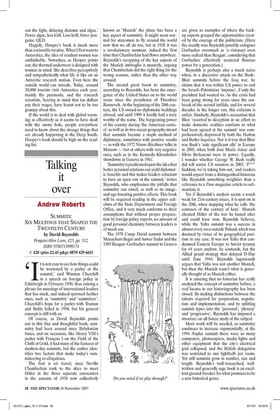Talking it over
Andrew Roberts SUMMITS: SIX MEETINGS THAT SHAPED THE TWENTIETH CENTURY by David Reynolds Penguin/Allen Lane, £25, pp. 512, ISBN 9780713999174 © £20 (plus £2.45 p&p) 0870 429 6655 ‘I t is not easy to see how things could be worsened by a parley at the summit,' said Winston Churchill in a speech on foreign policy in Edinburgh in February 1950, thus coining a phrase for meetings of international leaders that has stuck, and indeed spawned further ones, such as 'summitry' and `summiteef . Churchill's hope for a parley with Truman and Stalin failed in 1950, but his general concept is still with us.
Of course, as David Reynolds points out in this fine and thoughtful book, summitry had been around since Babylonian times, and on occasions, like Henry VIII's parley with Francois I on the Field of the Cloth of Gold, it had many of the features of modern-day summits, but the author identifies two factors that make today's summiteering so ubiquitous.
The first is air travel; since Neville Chamberlain took to the skies to meet Hitler in the three separate encounters in the autumn of 1938 now collectively known as 'Munich' the plane has been a key aspect of summitry It might seem normal for statesmen to fly around the world now that we all do too, but in 1938 it was a revolutionary moment, indeed the first time that Chamberlain had flown anywhere. Reynolds's recapping of the key aspects of the Munich imbroglio is masterly, arguing that Chamberlain did the right thing for the wrong reasons, rather than the other way around.
The second great boost to summitry, according to Reynolds, has been the emergence of the United States on to the world scene since the presidency of Theodore Roosevelt. At the beginning of the 20th century, the US owned no diplomatic buildings abroad, and until 1909 it hardly had a navy worthy of the name. The burgeoning power of the country during `the American century' as well as its two-ocean geography meant that summits became a staple method of diplomacy, sometimes with positive results — as with the 1972 Nixon–Brezhnev talks in Moscow — but at others with very negative ones, such as in the Kennedy–Khrushchev showdown in Geneva in 1961.
'Summitry is predicated upon the idea that better personal relations can yield diplomatic benefits and this makes leaders reluctant to have an open row at the summit,' writes Reynolds, who emphasises the pitfalls that summitry can entail, as well as its imageand ego-boosting positive effects. This book will be required reading in the upper echelons of the State Department and Foreign Office, and it very much conforms to their assumptions that without proper preparation by foreign policy experts, no amount of good personal chemistry between leaders is of much use.
The 1978 Camp David summit between Menachem Begin and Anwar Sadat and the 1985 Reagan–Gorbachev summit in Geneva are given as examples of where the backup experts grasped the opportunities created by the courage of the politicians. (Here the usually wise Reynolds possibly eulogises Gorbachev overmuch as 'a visionary even more radical than Reagan', considering that Gorbachev effectively neutered Russian power for a generation.) Reynolds is perhaps also a touch naive when, in a discursive attack on the Bush– Blair summits before the Iraq war, he claims that it was within US power to end the Israeli–Palestinian 'impasse', if only the president had wanted to. As the crisis had been going strong for years since the outbreak of the second intifida, and for several decades in the longer run, this criticism is unfair. Similarly, Reynolds's accusation that Blair 'resorted to deception in an effort to make domestic realities conform to what had been agreed at the summit' was comprehensively disproved by both the Hutton and Butler inquiries. Nor is it true that Blair was Bush's 'sole significant ally' in Europe in 2003, when both Jose Maria Aznar and Silvio Berlusconi were in power. Equally, I wonder whether George W. Bush really did tell senior US senators in 2003: F*** Saddam, we're taking him out,' and readers would expect from a distinguished historian like Reynolds something weightier than a reference to a Time magazine article to substantiate it.
Yet if Reynolds's analysis seems a touch weak for 21st-century issues, it is spot-on in the 20th, when mapping what he calls `the contours of the century of hate'. Munich cheated Hitler of the war he lusted after and could have won, Reynolds believes, while the Yalta summit was a success in almost every area outside Poland, which was doomed by virtue of its geographical position in any case. It was not Yalta that condemned Eastern Europe to Soviet tyranny for 44 years anyhow, he contends, but the Allied grand strategy that delayed D-Day until June 1944. Reynolds ingeniously argues that Yalta was not another Munich, but then the Munich wasn't what is generally thought of as Munich either.
It is amazing that no historian has really analysed the concept of summitry before; a real lacuna in our historiography has been closed. By making distinctions between the talents required for preparation, negotiation and implementation, and by splitting summit types into the 'personal', 'plenary' and 'progressive', Reynolds has imposed a structure on all future study of the subject.
More work will be needed, as summitry continues to increase exponentially; at the 1994 Naples summit there were so many computers, photocopiers, media lights and other equipment that the city's electrical grid collapsed, and the British delegation was restricted to one lightbulb per room. Yet still summits grow in number, size and length. Reynolds's well-researched, wellwritten and generally sage book is an excellent ground-breaker for what promises to be a new historical genre.





































































 Previous page
Previous page